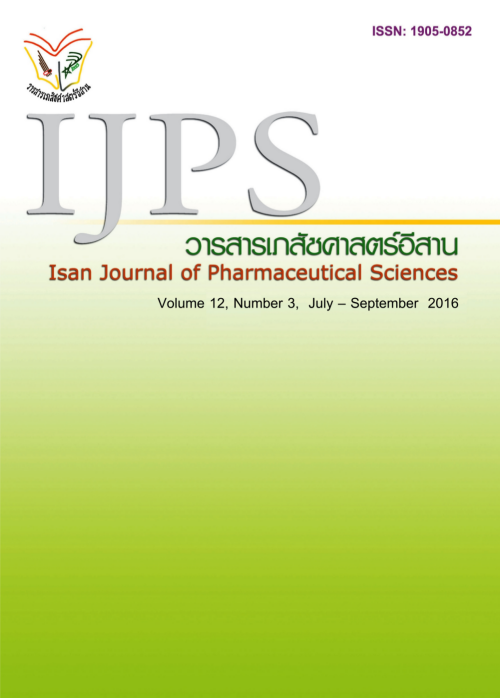Adverse drug events identification using trigger tools in hospitalized patients
Main Article Content
Abstract
The aims of the present study were to identify and describe adverse drug events by trigger tools. Data were collected from retrospective record review of 561 patient charts which had 1 or more trigger tools and admissions longer than 48 hours during January to June 2014. The 4 trigger tools investigated in this study were calcium polystyrene sulphonate (Kalimate®), chlorpheniramine maleate injection (CPM injection), vitamin K injection (Konakion®) and naloxone injection (Narcan®). The particular adverse drug events which occurred during the admissions were counted and identified. The results showed that Kalimate® and vitamin K injection were prescribed most often (36.6% and 35.8% respectively) followed by CPM injection (27.5%). No naloxone injection was prescribed during the study time. The combined positive predictive value (PPV) of all trigger tools was 9.9% as follows Kalimate® 16.15% PPV, CPM injection 12.79% PPV, and vitamin K injection 1.34% PPV.
This study indicated that KCl injection and KCl elixir were the causes of hyperkalemia (K 5.5 - 7.7 mEq/L) leading to Kalimate® prescription. Antibiotics were the most common cause of hypersensitivity leading to CPM injection prescription (81.8%). Most hypersensitivity reactions were skin rash, particularly maculo-papular rash (50%). Warfarin was the cause of high INR levels (INR 7-10) leading to vitamin K injection prescription.
Trigger tools may be a useful method to identify adverse drug events in a short time continually using targeted chart review to find incidence of adverse drug events to improve patient safety.
Article Details
In the case that some parts are used by others The author must Confirm that obtaining permission to use some of the original authors. And must attach evidence That the permission has been included
References
Brenner S, Lopez A, Horton C, et al. Signal and noise: applying a laboratory trigger tool to identify adverse drug events among primary care patients. BMJ. 2012:1-6.
Carnevali L, Krug B, Amant F,et al. Performance vof the Adverse Drug Event Trigger Tool and Global Trigger Tool for Identifying Adverse Drug Event: Experience in a Belgian Hospital. Carnevali et al Annals of Pharmacotherapy. 2013;11:1414-9.
Eckstrand JA, Williamson A, Horvath MM, et al. Computerized surveillance of opioid-related adverse drug events in periperative care: a cross-sectional study. Patient safety in surgery. 2009:1-7.
Franklin BD, Schachter M, Barber N. Testing a trigger tool as a method of detecting harm from medication errors in UK hospital: apilot study. Int J Pharm Pract. 2010;5:305-11.
Gandhi TK. Identifying drug safety issues: from research to practice. Int J Qual Health Car. 2000;12(1):69-76.
Jha AK, Kuperman GJ, Teich JM, et al. Identifying adverse drug events: development of a computer-based monitor and comparison with chart review and stimulated voluntary report. JAMIA. 1998;5:305-314.
Monruedee Pettae. The Use of Trigger Tools for Identification of Adverse Drug Events. TJPP. 201;3-5.
Murff HJ , Hripcsak G , Bates DW. Detecting adverse events for patient safety research: a review of current methodologies. . J Biomed Inform. 2003;36:131.
Narak Yeesoonpan, et al. Detecting adverse drug events by trigger tool at a Provincial hospital in Thailand. TJPP. 2015;1:234-49.
Resar RK . Methodology and rationale for the measurement of harm with trigger tools. Qual Saf Heallth Care. 2003;12:39-45.
Rozenfeld S, GiordaniI F, Coelho S. Adverse drug events in hospital: pilot study with trigger tool. Rev Saude Publica. 2013;6:1102-11.
Rozich JD , Haraden CR, Resar RK. Adverse drug event trigger tool : a practical methodology for measuring medication related harm. Qual Saf Heallth Care. 2003;12:194-200.


